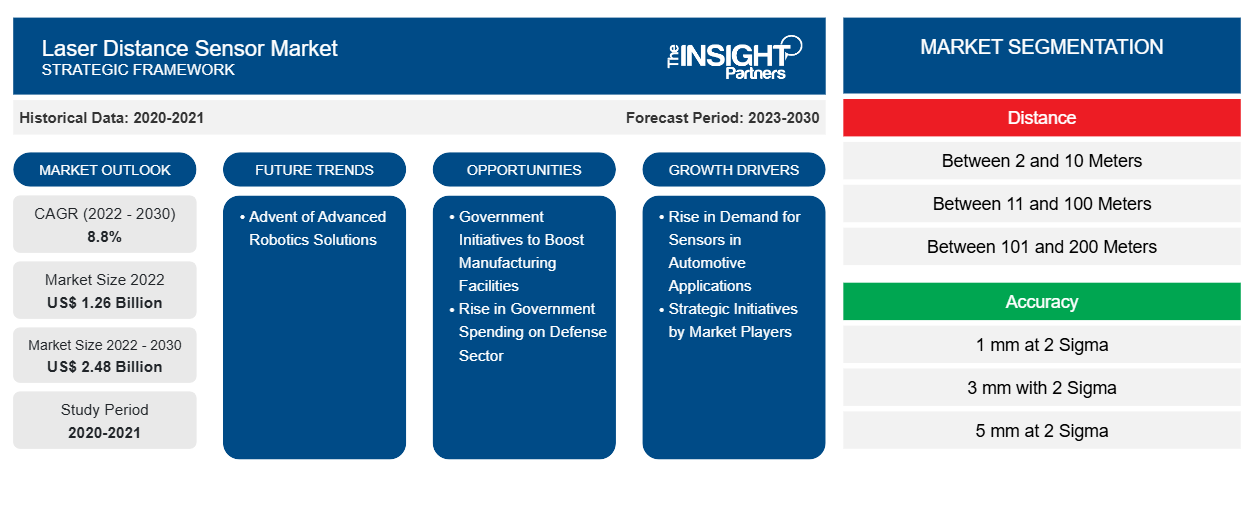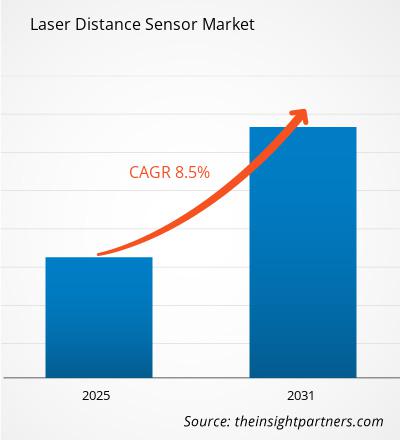The laser distance sensor market size was valued at US$ 2.14 billion in 2024 and is expected to reach US$ 3.73 billion by 2031; it is estimated to register a CAGR of 8.5% during 2025–2031. Advent of advanced robotics solutions is likely to remain a key market trend.
Laser Distance Sensor Market Analysis
The rise in government focus on the automation of manufacturing facilities generates the demand for laser distance sensors. The advanced sensing application helps enhance the operational efficiencies in the manufacturing facilities. Therefore, the increase in government investments to boost the manufacturing industry fosters the laser distance sensor market growth. In addition, the automotive industry is one of the major applications of laser distance sensors. The integration of advanced technologies in automotive vehicles drives the laser distance sensor market.
Laser Distance Sensor Market Overview
A laser distance sensor is a component that uses a laser beam to calculate the distance between the objects. These sensors measure distances and enable accurate measurements over long ranges. They work based on the time-of-flight (ToF) principle, where the sensor emits a laser beam and receives its reflection. The time that elapses between sending and receiving the laser beam light helps the laser distance sensor determine the distance.
Customize This Report To Suit Your Requirement
You will get customization on any report - free of charge - including parts of this report, or country-level analysis, Excel Data pack, as well as avail great offers and discounts for start-ups & universities
Laser Distance Sensor Market: Strategic Insights

-
Get Top Key Market Trends of this report.This FREE sample will include data analysis, ranging from market trends to estimates and forecasts.
Laser Distance Sensor Market Drivers and Opportunities
Rise in Demand for Sensors in Automotive Applications
The automotive industry is growing rapidly with the rising technological developments. Vehicles rely on effective sensing to allow automated systems to assist drivers and provide better safety, comfort, and convenience. Laser distance sensors are used in autonomous vehicles for various purposes, such as localization, obstacle detection, and picking or placing objects. The technology helps detect objects and provides information on their position and movements within the three-dimensional space. It also assists in identifying the object by detecting its size, shape, and orientation.
The continuous transformation across the automotive industry has triggered the demand for advanced driver-assistance systems (ADAS) and light detection and ranging (LiDAR). With the increasing emphasis on requirements for high levels of accuracy and heterogeneous signal redundancy in ADAS and LiDAR applications, the demand for laser distance sensors is rising. Various automotive manufacturing giants are focusing on ADAS and LiDAR technology. Thus, the adoption of ADAS technology by automakers generates the demand for laser distance sensors to enhance the reliability required for advanced levels of automation in vehicles, which further fuels the laser distance sensor market growth.
Government Initiatives to Boost Manufacturing Facilities
Industry 4.0 is transforming how companies manufacture, process, and distribute their products and are focused on improving product quality by minimizing the risk of human error and providing a safe environment. Due to the rise in the adoption of Industry 4.0, the governments of various countries are investing to boost their manufacturing industry further. For example, in March 2025, Johnson & Johnson announced a new US$ 55 billion investment in the US over the next four years in manufacturing, research and development, and technology. In addition, initiatives such as Make in India and Made in China 2025 are supporting market players in expanding their manufacturing capacity and adopting advanced technologies to catalyze their production output and enhance the efficiency of their final products. The rise in industrialization contributes to the construction of new manufacturing facilities across various industry verticals, such as automotive, food & beverages, and chemicals, further fueling the need for automated solutions to carry out certain tasks. Laser distance sensors can play a vital role in providing real-time, precise, and accurate measurements for enhanced and error-free manufacturing processes. Newly built automated manufacturing facilities generate the demand for components required for improved quality control, enhanced productivity, and overall cost-effectiveness. Thus, the governments' focus on boosting the manufacturing facilities and integrating automation is anticipated to create lucrative opportunities for the laser distance sensor market growth.
Laser Distance Sensor Market Report Segmentation Analysis
Key segments that contributed to the derivation of the laser distance sensor market analysis are wavelength, power range, and end user.
- Based on wavelength, the laser distance sensor market is segmented into 200–650 nm, 651–1100 nm, 1101–3000 nm, and 3001 nm and above. The 3001 nm and above segment held the largest market share in 2024.
- Based on power range, the laser distance sensor market is divided into less than 1 mW, 1–100 mW, 101 mw to 500 mw, and above 500 mw. The 101 mw to 500 mw segment held the largest market share in 2024.
- Based on industry vertical, the market is segmented into manufacturing, construction, automotive and robotics, aerospace and defense, geospatial industry, environmental monitoring, and others. The automotive and robotics segment held the largest laser distance sensor market share in 2024.
Laser Distance Sensor Market Share Analysis by Geography
- The laser distance sensor market is segmented into five major regions: North America, Europe, Asia Pacific (APAC), the Middle East & Africa (MEA), and South & Central America. Asia Pacific dominated the market in 2024, followed by North America and Europe.
- In Asia Pacific, the rising industrial automation across countries such as India, China, and Japan is a major factor driving the market growth. The widespread adoption of industrial automation in various sectors, including manufacturing, logistics, and automotive, is a significant driver for the laser distance sensor market. Laser distance sensors play a crucial role in automation by providing accurate and reliable distance measurements, enabling precise positioning, object detection, and collision avoidance. In July 2024, BYD, a Chinese automaker, opened its first electric vehicle factory in Thailand, marking a significant expansion into Southeast Asia. In this rapidly growing market, the company has established itself as the leading player. The BYD plant is part of a wave of investment worth more than US$ 1.44 billion from Chinese EV makers who are setting up factories in Thailand, helped by government subsidies and tax incentives. This substantial order highlights BYD's commitment to leveraging advanced automation technologies and enhancing operational efficiency in the manufacturing process.
Laser Distance Sensor Market Regional Insights
The regional trends and factors influencing the Laser Distance Sensor Market throughout the forecast period have been thoroughly explained by the analysts at The Insight Partners. This section also discusses Laser Distance Sensor Market segments and geography across North America, Europe, Asia Pacific, Middle East and Africa, and South and Central America.
Laser Distance Sensor Market Report Scope
| Report Attribute | Details |
|---|---|
| Market size in 2024 | US$ 2.14 Billion |
| Market Size by 2031 | US$ 3.73 Billion |
| Global CAGR (2025 - 2031) | 8.5% |
| Historical Data | 2021-2023 |
| Forecast period | 2025-2031 |
| Segments Covered |
By Wavelength
|
| Regions and Countries Covered |
North America
|
| Market leaders and key company profiles |
|
Laser Distance Sensor Market Players Density: Understanding Its Impact on Business Dynamics
The Laser Distance Sensor Market is growing rapidly, driven by increasing end-user demand due to factors such as evolving consumer preferences, technological advancements, and greater awareness of the product's benefits. As demand rises, businesses are expanding their offerings, innovating to meet consumer needs, and capitalizing on emerging trends, which further fuels market growth.

- Get the Laser Distance Sensor Market top key players overview
Laser Distance Sensor Market News and Recent Developments
The laser distance sensor market is evaluated by gathering qualitative and quantitative data post primary and secondary research, which includes important corporate publications, association data, and databases. A few of the developments in the laser distance sensor market are listed below:
- ifm Electronic GmbH, a prominent German sensor and automation company, has expanded its presence in Indonesia to contribute to the success of the country’s “Making Indonesia 4.0” initiative. The company established its Indonesian subsidiary, PT ifm electronic Indonesia, on October 10, 2022. Subsequently, on August 3, 2023, ifm Electronic GmbH officially inaugurated its office in Sentral Senayan II, Jakarta, with a grand opening ceremony. This move underscores the company’s commitment to engaging with the Indonesian market and supporting the country’s industrial advancement endeavors. (Source: ifm Electronic GmbH, Press Release, August 2023)
- The Baumer Group, a leading manufacturer of sensors, encoders, measurement instruments, and automated imaging components, has opened a new subsidiary in Mexico. With the new office in Santiago de Querétaro, Mexico, Baumer is now present in 19 countries around the world, operating 39 development centers, production sites and sales units.
(Source: The Baumer Group, Press Release, January 2025)
Laser Distance Sensor Market Report Coverage and Deliverables
The "Laser Distance Sensor Market Size and Forecast (2021–2031)" provides a detailed analysis of the market covering the areas mentioned below:
- Laser distance sensor market size and forecast at global, regional, and country levels for all the key market segments covered under the scope
- Laser distance sensor market trends, as well as market dynamics such as drivers, restraints, and key opportunities
- Detailed PEST and SWOT analysis
- Laser distance sensor market analysis covering key market trends, global and regional framework, major players, regulations, and recent market developments
- Industry landscape and competition analysis covering market concentration, heat map analysis, prominent players, and recent developments for the laser distance sensor market
- Detailed company profiles
Frequently Asked Questions
What are the future trends of the laser distance sensor market?
Which are the key players holding the major market share of laser distance sensor market?
What will be the laser distance sensor market size by 2031?
Which region is holding the major market share of laser distance sensor market?
What are the driving factors impacting the laser distance sensor market?
What is the estimated global market size for the laser distance sensor market in 2024?
- Historical Analysis (2 Years), Base Year, Forecast (7 Years) with CAGR
- PEST and SWOT Analysis
- Market Size Value / Volume - Global, Regional, Country
- Industry and Competitive Landscape
- Excel Dataset
Recent Reports
Related Reports
Testimonials
Reason to Buy
- Informed Decision-Making
- Understanding Market Dynamics
- Competitive Analysis
- Identifying Emerging Markets
- Customer Insights
- Market Forecasts
- Risk Mitigation
- Boosting Operational Efficiency
- Strategic Planning
- Investment Justification
- Tracking Industry Innovations
- Aligning with Regulatory Trends





















 Get Free Sample For
Get Free Sample For